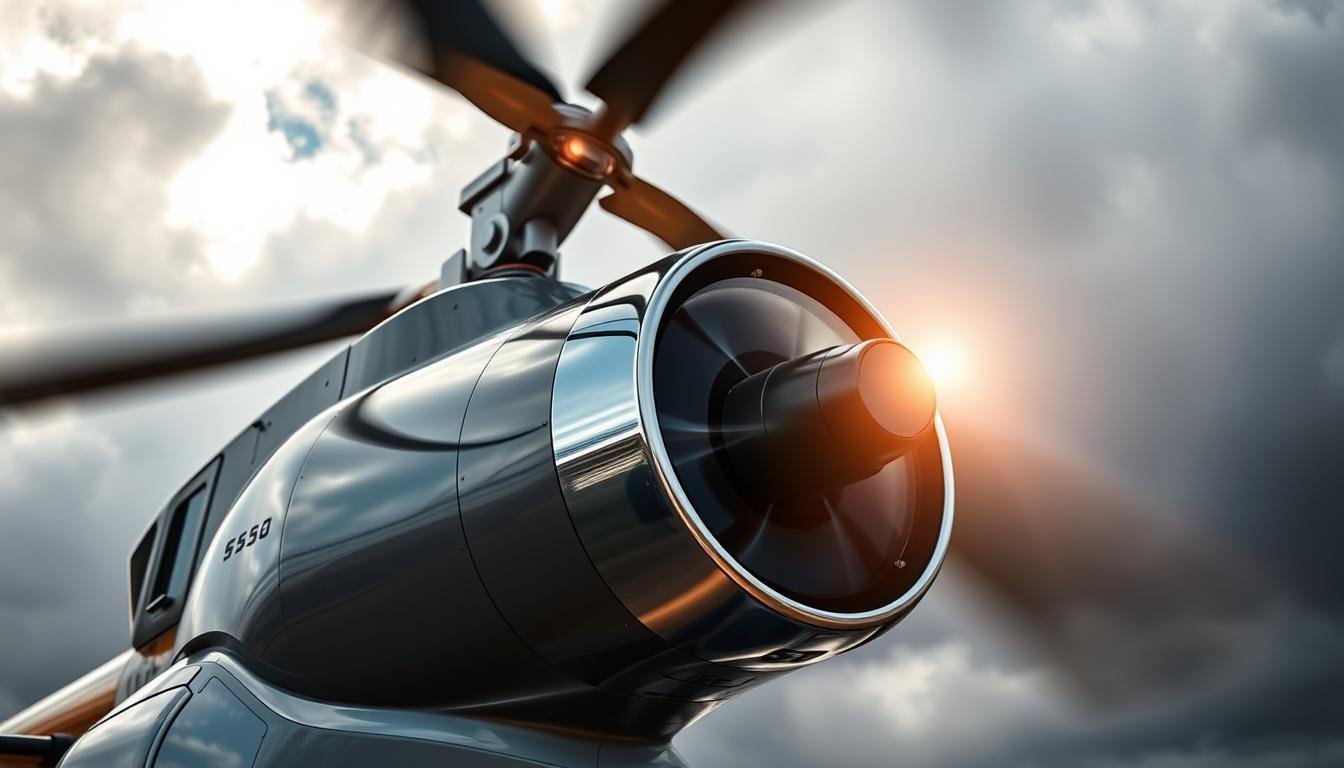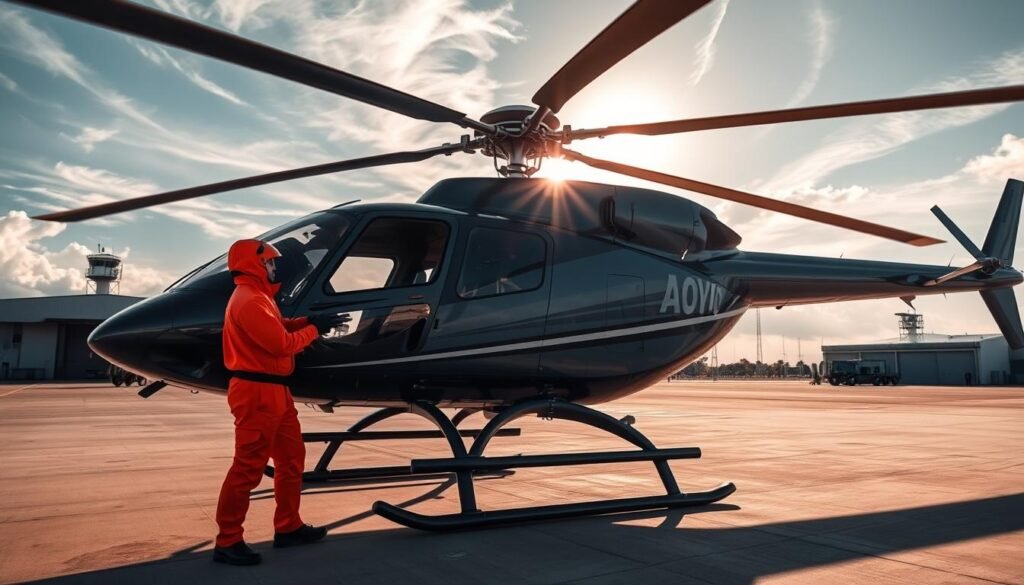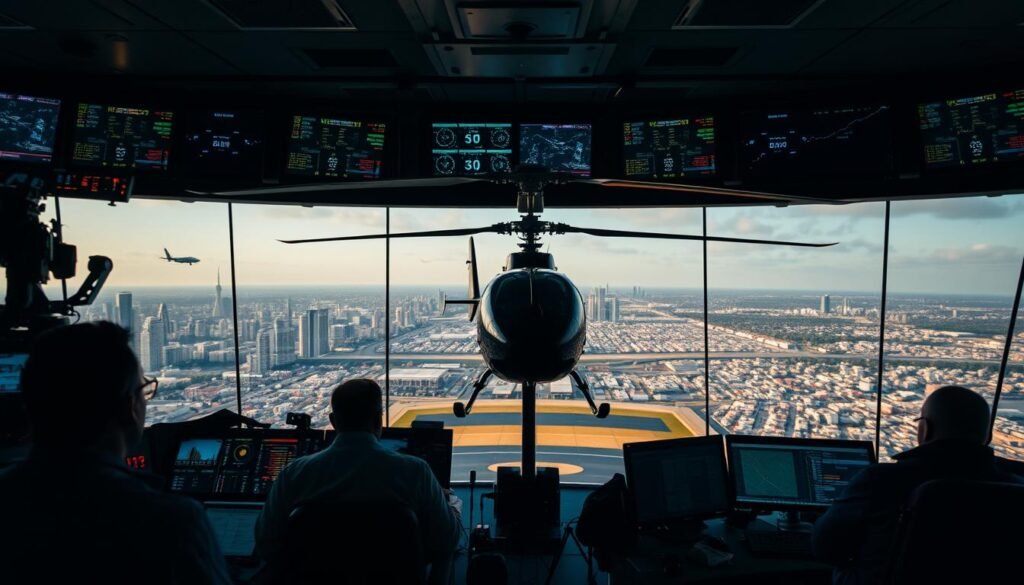Helicopter Flight Safety begins with a stark fact: even seasoned crews have been fatally injured by slowly turning main rotors during shutdown when blades spin at just 20–30 RPM.
That risk shows why approach and departure must be deliberate and coordinated with the pilot. Teams must remove distractions, secure loose items, and maintain eye contact to reduce mistakes.
A structured culture built on clear protocols like STAR (Stop, Think, Assess, Rate) and rotor disc awareness cuts preventable harm. The guide that follows turns real-world experience into concise, repeatable safety tips and step-by-step actions for preflight, in-air, and shutdown procedures.

Readers will learn why small choices—stowing a phone, keeping a low profile near turning blades, and using conservative minimums—matter in adverse weather. For deeper operational details on handling poor visibility and gusts, see this practical resource on bad-weather operations: bad weather tips.
Key Takeaways
- Prioritize life over mission pressure with disciplined, repeatable procedures.
- Use STAR and rotor-disc awareness to reduce ground hazards.
- Apply conservative minimums and pre-departure checklists every time.
- Small habits—phones away, steady approach, clear communication—prevent incidents.
- Train responses for degraded weather to boost crew and equipment protection.
Helicopter Flight Safety Foundations For Bad Weather Operations
When conditions worsened, crews relied on simple rules to preserve margin and avoid risk. The foundation combined clear procedures, routine training, and a conservative mindset so the team de‑escalated exposure rather than forcing a mission.
Adopt A “Better Safe Than Sorry” Mindset For Every Flight
The pilot reframed choices to reduce pressure to “make it work.” Teams paused, evaluated weather, and set go/no‑go limits. This way, risk was managed before it grown into an emergency.
Build A Safety Culture: STAR Method And Rotor Disc Protocols
Stop, Think, Assess, Rate was applied before approach. Stop at a visible distance. Think about intent and permission. Assess bags, slope, loose clothing, phone use, rotor RPM and blade sailing risk. Rate and proceed only after a clear pilot acknowledgement.
Coordinate Pilot, Passenger, And Ground Crew Procedures
Approach from the 10 or 2 o’clock position, crouch, keep eye contact, and never pass behind the tail rotor. Brief passengers to keep low, secure loose items, and move one at a time.
Control Distractions And Respect Start‑Up/Shutdown Risks
The company standardizes training so phones stay pocketed and gear is stowed. During start‑up and shutdown everyone respected blade sailing and waited until the pilot confirmed it was safe to pass.
How To Prepare Before Takeoff In Adverse Weather Conditions
Preparation reduced last-minute pressure and kept crews from making risky choices. A focused pre-departure routine made complex tasks clear and repeatable.
Run IMSAFE And Personal Risk Assessment To Gauge Fitness To Fly
IMSAFE is completed before any dispatch decision so pilots confirm they are physically and mentally ready. If one element flags—illness, medication, stress, alcohol, fatigue, or emotion—the plan changes before the rotors turn.
Use A Pre‑Departure Checklist: Weather, Fuel, Documentation, And Safety Equipment
The checklist is reviewed end-to-end every time. It covers weather, fuel, documents, safety equipment, comms, and onboard monitors.
“A complete checklist reduces errors and makes the last-minute review systematic.”

Plan The Mission: Route, Altitude Strategy, And Weather Avoidance
Plan a conservative route with altitude buffers. Cruising above 1,000 feet reduces wire and tree conflicts; use wire strike protection for required low-level work.
Set Minimums And Go/No‑Go Criteria With Company Procedures
Written minimums remove improvisation. Pilots answer hard questions on visibility, ceilings, winds, and alternates before they commit to takeoff.
Equip For The Mission: HUMS, Terrain Alerts, And Wire Strike Protection
HUMS and terrain alerting such as EGWPS keep aircraft condition and terrain awareness high in demanding conditions.
Mitigate Liability And Operational Risk With Appropriate Insurance
Insurance is operational risk management. It protects careers and assets if a rare event occurs despite following safety tips and procedures.
| Item | Primary Benefit | When To Use |
|---|---|---|
| IMSAFE | Personal fitness check | Before dispatch |
| Pre‑Departure Checklist | Consistency and completeness | Every departure |
| HUMS / EGWPS | Mechanical and terrain alerts | Marginal weather or high workload |
| Wire Strike Protection | Obstacle mitigation | Low-level operations |
In‑Flight Techniques For Handling Wind, IMC, And Terrain
Maintaining energy and situational awareness is the best defense against sudden wind or reduced visibility. The pilot uses a simple hierarchy: fly the aircraft, navigate, then communicate. This rule preserves options and reduces chance of error.

Manage Wind Hazards: LTE, Mast Bumping, And Urban Mechanical Turbulence
In strong, shifting winds the pilot anticipates tail rotor demand to avoid LTE and keeps power margins. Disciplined pedal management and smooth cyclic inputs cut mast bumping risk.
Cross ridgelines with a way that minimizes rotor unloading and avoid abrupt control inputs in urban canyons.
Navigate IMC And Low Visibility: Instrument Discipline And 3‑D Weather Radar
Hold headings and altitudes precisely and cross‑check instruments. Use advanced radar like Primus or IntuVue to map cells and plan strategic deviations rather than last‑second turns.
For more on weather impacts, consult this weather impacts resource.
Avoid CFIT: Terrain Awareness, EGWPS, And Safe Altitude Practices
Keep EGWPS active and interpret alerts continuously. Add conservative altitude buffers above minima to reduce CFIT risk.
Control Workload And Fatigue
Task shedding is essential: fly, navigate, communicate. Use scheduling support like GoDirect Flight to manage pilot duty and fatigue with 24/7 oversight.
Leverage Crew Communication And Pilot Networks
Callouts for wind shifts, RPM trends, and terrain protect margins. Ground teams relay landing zone updates and peer debriefs capture local lessons for better practices.
| Threat | Mitigation | Tools |
|---|---|---|
| LTE / Tail Loss | Power margin, pedal management | Training, HUMS |
| Mast Bumping | Smooth cyclic, airspeed/G limits | Procedures, pilot discipline |
| CFIT | EGWPS, safe altitude buffers | EGWPS, terrain charts |
| Severe Weather Cells | Strategic deviations, 3‑D radar | Primus, IntuVue |
“Fly the aircraft first; keep options open and avoid reactive maneuvers.”
For operational challenges and local lessons, see this practical review on challenges faced by pilots.
Conclusion
When teams fuse mindset, protocol, and technology they create a repeatable way to reduce risk. Checklists, STAR and rotor‑disc protocols, conservative minimums, and recurrent training make that possible.
Modern systems — 3‑D radar, EGWPS and HUMS history — complement judgment and raise reliability. Learn practical bad weather tips to plan diversions and protect margins.
Leaders who back crew decisions, remove distractions, and standardize call‑and‑response checks build durable practices. Insurance and debriefs align risk management with career protection.
Plan conservatively, brief thoroughly, fly precisely, and debrief candidly. By committing to these principles, pilots and pilot teams honor experience and keep helicopter operations safe across all flights.
FAQ
What mindset should a pilot adopt when planning a flight in poor weather?
They should adopt a “better safe than sorry” approach, prioritizing conservative decision‑making. That means delaying or cancelling when uncertainty exists, briefing passengers and crew, and using company go/no‑go criteria to guide the final call.
How can a crew build and maintain a strong safety culture on operations?
Teams should use structured tools like the STAR method and rotor disc protocols, hold regular briefings, report hazards without fear, and practice standard procedures so every person knows responsibilities during normal and abnormal events.
What predeparture checks are essential before leaving in adverse conditions?
The pilot must complete an IMSAFE personal assessment, verify weather and NOTAMs, confirm fuel and weight calculations, and ensure required equipment—terrain awareness, HUMS, and wire strike protection—are onboard and functional.
How should mission planning change in marginal weather?
Plan conservative routing and altitudes that avoid known hazards, identify alternates, set realistic fuel reserves, and use weather avoidance strategies such as terrain masking and timing flights around favorable windows.
What minimums and criteria should guide a go/no‑go decision?
Operators should set clear company minimums for visibility, ceiling, wind limits, and pilot currency. If conditions fall below those limits or the pilot feels unfit, the flight should be deferred or rerouted.
Which in‑flight techniques reduce risk when facing strong winds and turbulence?
Maintain appropriate airspeeds, use proper approach and departure paths to minimize mast bumping and LTE exposure, avoid areas of mechanical turbulence near structures, and brief the crew on expected handling changes.
How should crews handle instrument meteorological conditions and low visibility?
They should rely on instrument discipline, cross‑check avionics including 3‑D weather radar, adhere to published procedures, and execute missed approaches or diversions promptly rather than pushing on in marginal IMC.
What practices help prevent controlled flight into terrain (CFIT)?
Use terrain awareness systems, set safe altitude baselines, brief escape routes, and keep vigilant radar and GPS monitoring. When terrain or obscuration is present, increase margins and consider holding or diverting.
How can distractions be controlled during critical phases like approach and departure?
Enforce sterile cockpit rules, secure loose gear and devices, delegate nonessential tasks, and ensure passengers and ground crew follow boarding and loading discipline to avoid last‑minute interruptions.
What risks exist during startup and shutdown, and how are they mitigated?
Blade sailing, tail rotor strikes, and personnel exposure are common. Mitigation includes clear rotor‑area procedures, a trained ramp crew, marked safe zones, and communication before any movement near the rotors.
How should pilots manage workload and fatigue on multi‑leg or demanding missions?
They should follow duty‑time limits, use sensible scheduling, prioritize tasks, take planned rest, and distribute tasks across the crew. Recognizing fatigue early and deferring flights prevents degraded performance.
What role do maintenance and monitoring systems play in adverse‑condition ops?
Health and usage monitoring systems (HUMS) and timely maintenance reduce mechanical surprises. Regular inspections, trend monitoring, and prompt corrective action keep the aircraft reliable in harsh environments.
How can operators mitigate legal and financial risk for harsh‑weather flights?
Maintain up‑to‑date insurance, document risk assessments and decisions, follow company procedures, and ensure all personnel meet training and currency requirements to support defensible choices if an incident occurs.
When should a pilot call for assistance or consult peer networks during a mission?
Seek help when weather deteriorates beyond training or company limits, when unexpected system failures occur, or when terrain and airspace complexity exceed resources. Peer input and ATC coordination improve situational awareness.. Safety should always come first when flying in challenging weather.
Related Articles
- How to Avoid Common Helicopter Pilot Errors: A Guide to Safe Flying
- The Role of Air Traffic Control in Helicopter Safety
- Helicopter Safety in Bad Weather: Tips for Flying in Adverse Conditions
- How to Safely Land a Helicopter in Challenging Conditions
- The Importance of Proper Helicopter Maintenance for Flight Safety
More from This Category
- Understanding Helicopter Weight and Balance: Why It’s Crucial for Safe Flying
- Emergency Procedures in Helicopter Flights: How to Handle In-Flight Incidents
- Helicopter Pre-Flight Inspections: What Pilots Must Check Before Takeoff
- How to Prepare for Your First Helicopter Ride: Safety Procedures for Passengers
- Top 10 Helicopter Safety Tips Every Pilot Should Know



